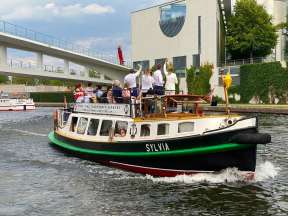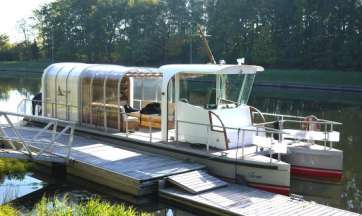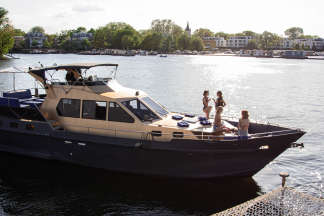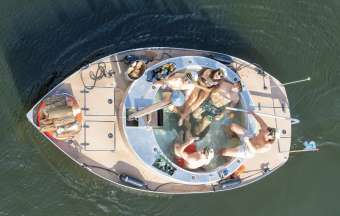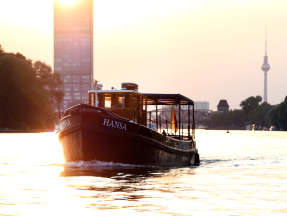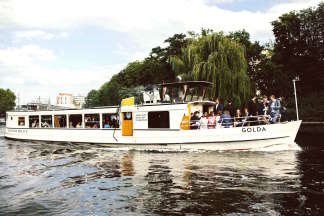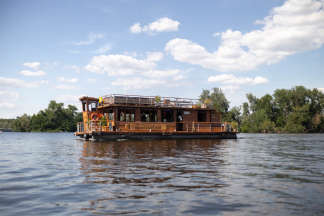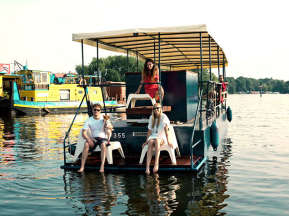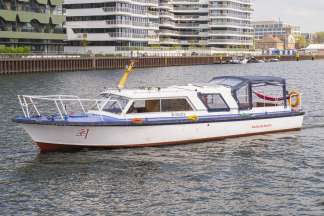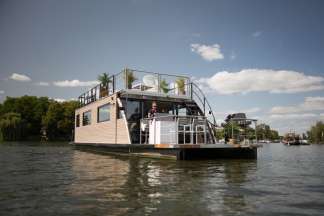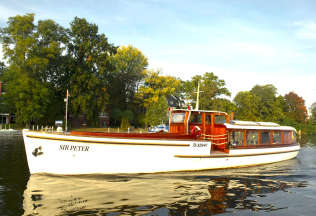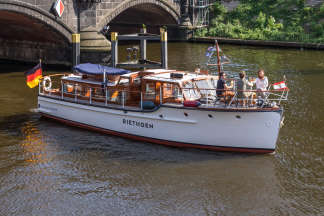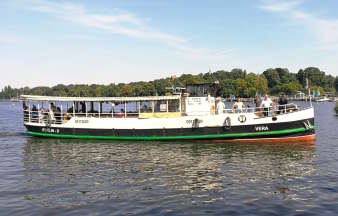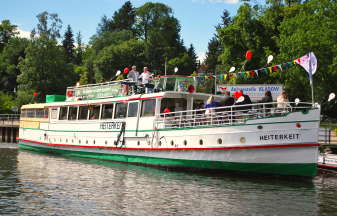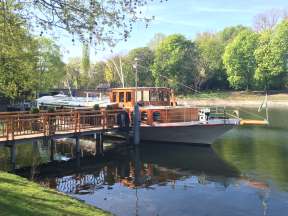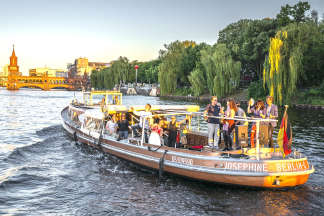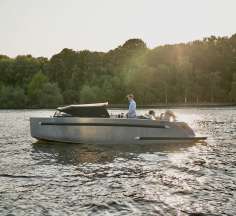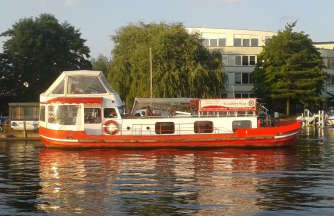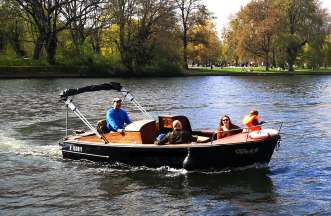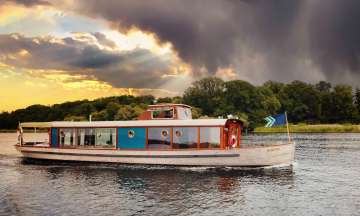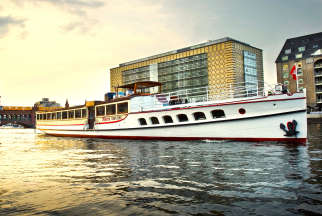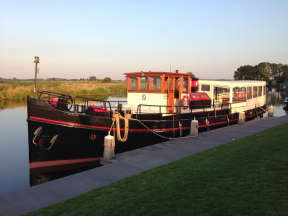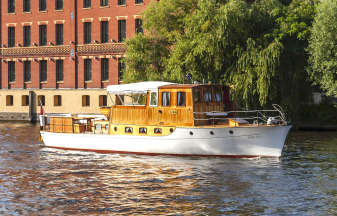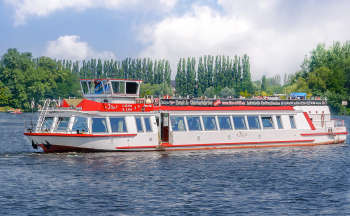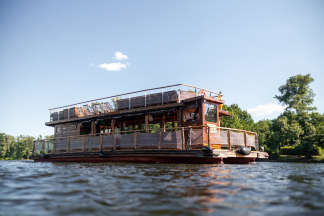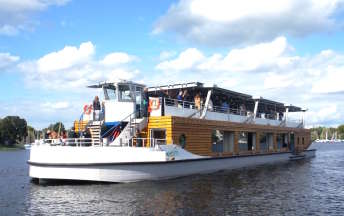Spree cruise Berlin
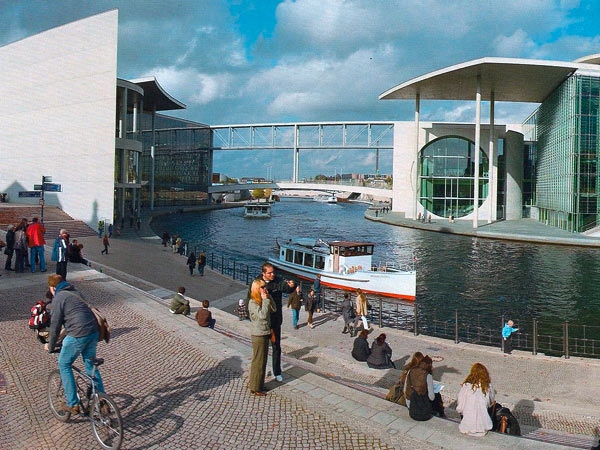
Sights on a Spree cruise from east to west
Two hours: Your boat trip leads through Berlin's wild east between Mühlendammschleuse (Fischerinsel) and the Rummelsburger Bucht. On this route you sail past notorious party locations such as the Kater Holzig, the Holzmarkt, the East Side Gallery, the Oberbaumbrücke, the Badeschiff, the Molecule Men and the Isle of Youth.
Three hours: This classic Berlin city tour takes you past the Berlin Cathedral, Museum Island, Central Station, the Chancellery and the House of World Cultures. On both banks of the Spree there are many beach bars such as Capital Beach, Sage Beach and the Strandbar Mitte. This is probably the best known route of Berlin.
Four hours: Your boat trip can take you towards Lake Müggelsee and New Venice (Berlin district Rahnsdorf). It's worth planning some extra time for a swim in Lake Müggelsee on this boat tour. The route takes about 90 to 120 minutes per direction.
Where do Spree tours start in Berlin?
Suitable boats for these routes start at the Historical Port Berlin (Fischerinsel) and Oberbaum Bridge. Some boat tours also start at Caprivi Bridge (Charlottenburg) and Friedrichstraße (Mitte). If you prefer to book tickets for a large passenger ship spontaneously, contact the big passenger ship companies "Stern und Kreis" or "Reederei Riedel".
Insel der Jugend
After the war, the island was renamed as the 'Insel der Jugend' (Island of Youth). The island became a very popular spot for people to party on barges during the 70s. They used to have concerts on the island and many famous DDR/ GDR bands used to play for free because it was seen as such an honor to play here. In 1984, the youth club 'INSEL' took over and to this day continue the traditions of hosting small concerts, open air cinemas and much more.
In 2010, the name of the island changed to the simple 'Insel Berlin'. Our boat trip follows the Spree River towards the city center, passing Treptow Harbor on the port side and passing under the Elsen Bridge.
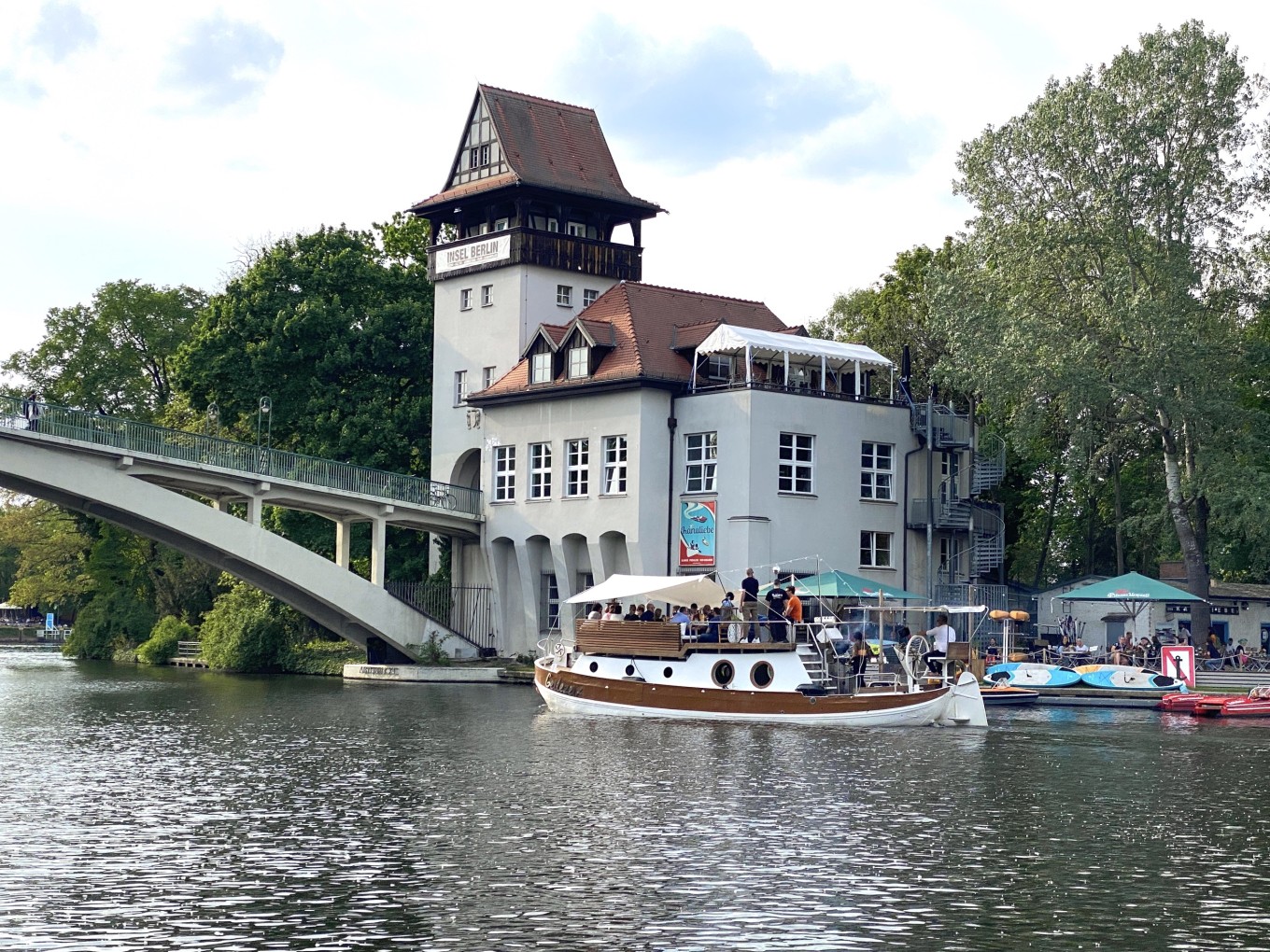
Molecule Men
The 'Molecule Men' are situated right behind the Elsen-bridge (going from East to West) and were built in 1999 by artist Jonathan Borofsky. They stand between the Elsen Bridge and the Hoppetosse.
The three figures of men are about 30 meters high and consist of punctured aluminium and stand facing each other. The whole piece weighs approximately 45 tons. The sculptor was fascinated how the punctured holes symbolised the power of molecules.
Borofsky had already finished his first molecule-sculptures in 1977 in Los Angeles. The location and structure of the figures are highly symbolic. This very point is where the three districts, Treptow, Friedrichshain and Kreuzberg, meet and so do the East and West.
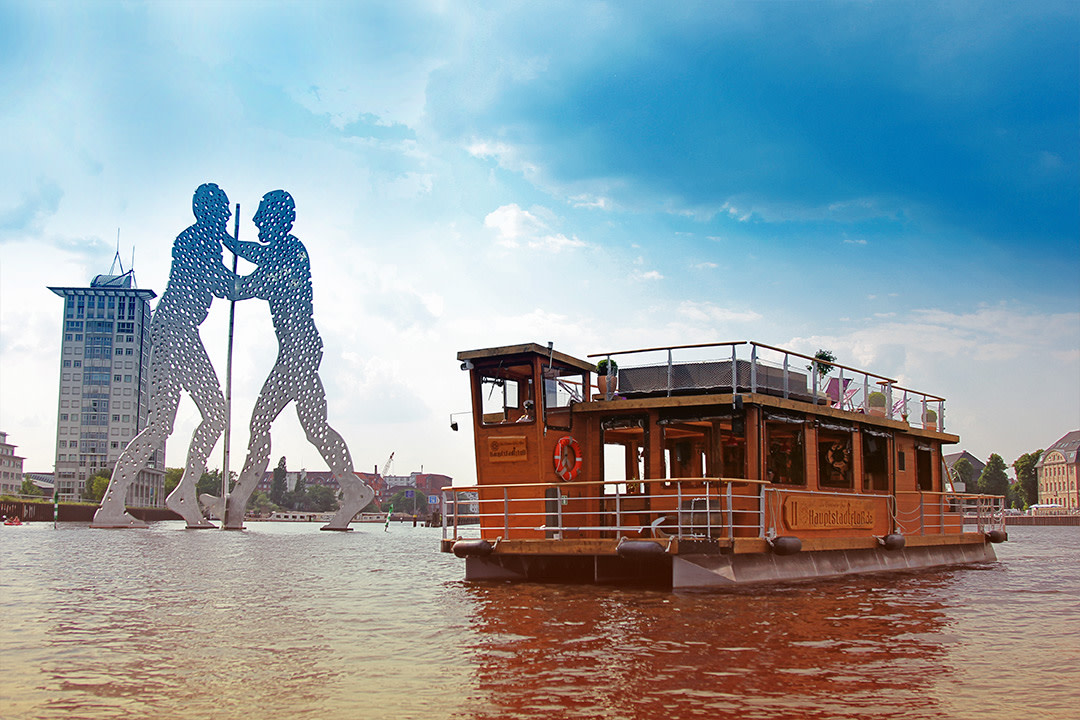
Hoppetosse and Badeschiff
The name 'Hoppetosse' comes from the Swedish authour, Astrid Lindgren's books. The Hoppetossa (slang for frog or mythical ghost) was the name of Efraim Langstrumpf's boat. That's right, Pippi Langstrumpf's father.
The Hoppetosse is the restaurant boat and along with the Badeschiff belong to the Arena Berlin (which will be our next sight on our boat tour through Berlin). The Badeschiff is a barge that's been turned into a swimming pool. In fact, it's the middle part of the former towing unit that's been kitted out with swimming pool equipment.
This is a very popular spot in the summer for people to enjoy the pool and sand bar. The pool is 32,50m long and 8,20m wide. Should you fancy taking a quick jump into the pool while on this boat tour, you'll quickly get to know the attentive lifeguards who are very eager to give their whistles a blast. The Badeschiff is definitely worth a closer look while on a boat tour through Berlin.
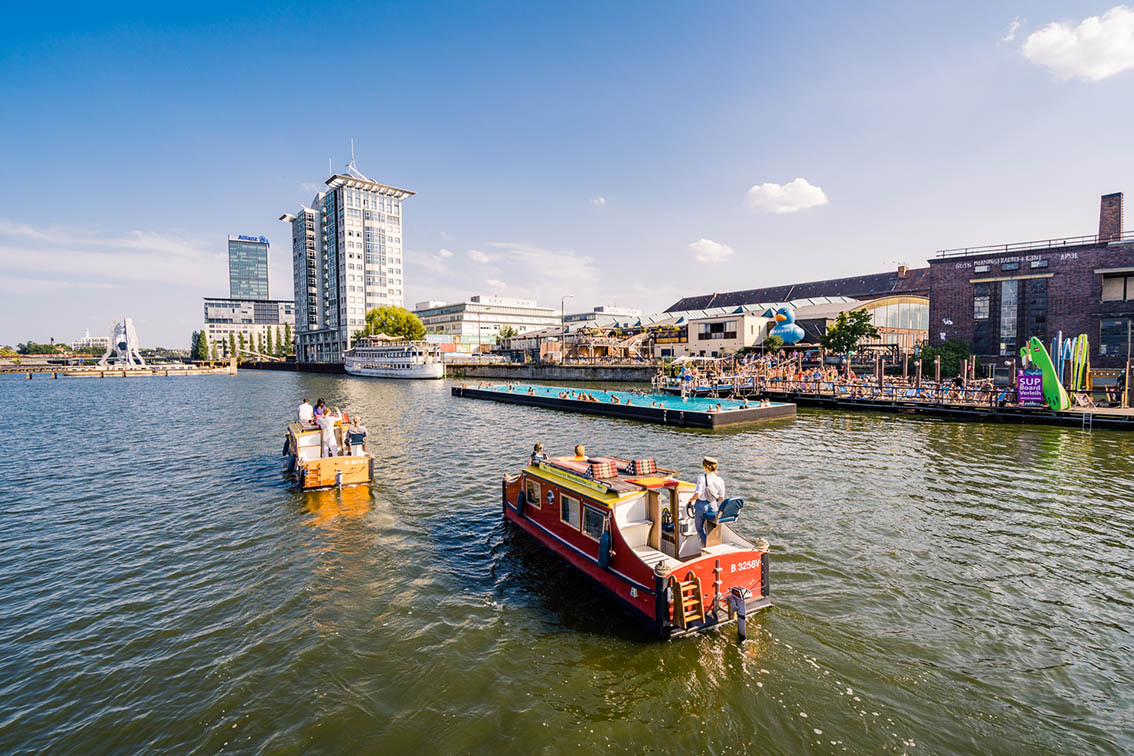
Media Spree Berlin
The term 'Media Spree' refers to the city's biggest investment project. This is the area that runs alongside the shore lines of the Spree, covering 3,7 km between Elsen-bridge in the East and the Oberbaum-bridge, Schilling-bridge, Michael-bridge, and Jannowitz-bridge in the West.
Along the River Spree, you'll find undeveloped land that was primarily used as industrial and commercial buildings from the last century. The most prominent examples are found on the Eastern Harbour and the East Side Gallery. In the future, they plan to build offices, luxury apartments.
Unfortunately, this investment project is affecting some of the city's most famous beach parties. Bar 25, for example, was probably one of the hottest and most spectacular techno clubs on Berlin's party scene. Its closure in September 2010 symbolised the ongoing restructuring process of large parts of the city. The bar was a real eye-catcher at night on any Spree River cruise.
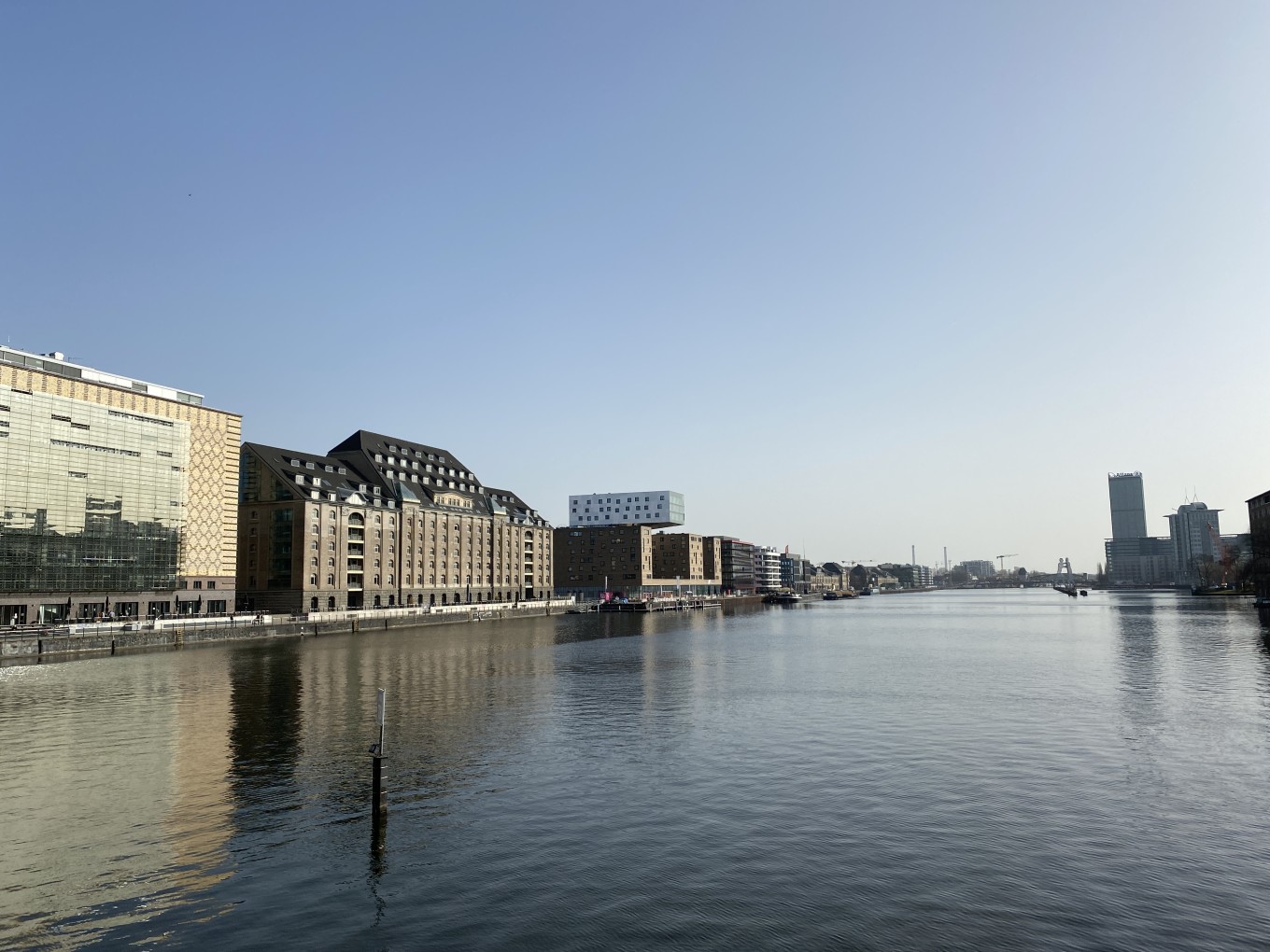
Oberbaumbrücke
Next stop of your River Spree Cruise: The Oberbaum Bridge is located right behind the Oberschleuse (which leads into the Landwehr Canal). This is undoubtedly Berlin's most beautiful bridge, covering 150m in length and combining the two districts Friedrichshain and Kreuzberg.
It was built in 1894 and cost 2 million Goldmarks at the time. The building inspector Pinkenburg and the architect, Otto Stahn, oversaw this project. There's a pedestrian pathway under the railway viaduct that closely resembles a crossing from the middle ages. The middle archway is supported by two 34m high towers, which used to serve as Berlin's water gateway. The two reliefs at the top of the towers carry the Berlin bear and the Brandenburg eagle.
Adolf Hitler had the bridge partially blown up in 1945 in order to stop the Russians advancing. The middle archway was completely destroyed in the process. During the post-war period, the bridge was rather poorly repaired with a steel structure, which then served as a border between the Soviet sector in the East and American sectors in western Berlin. After the reunification, the bridge was fully restored in 1995 for 70 million DM and took up its position again as a historical symbol of Berlin. The Oberbaum Bridge is an integral part of any trip on the Spree River in Berlin.
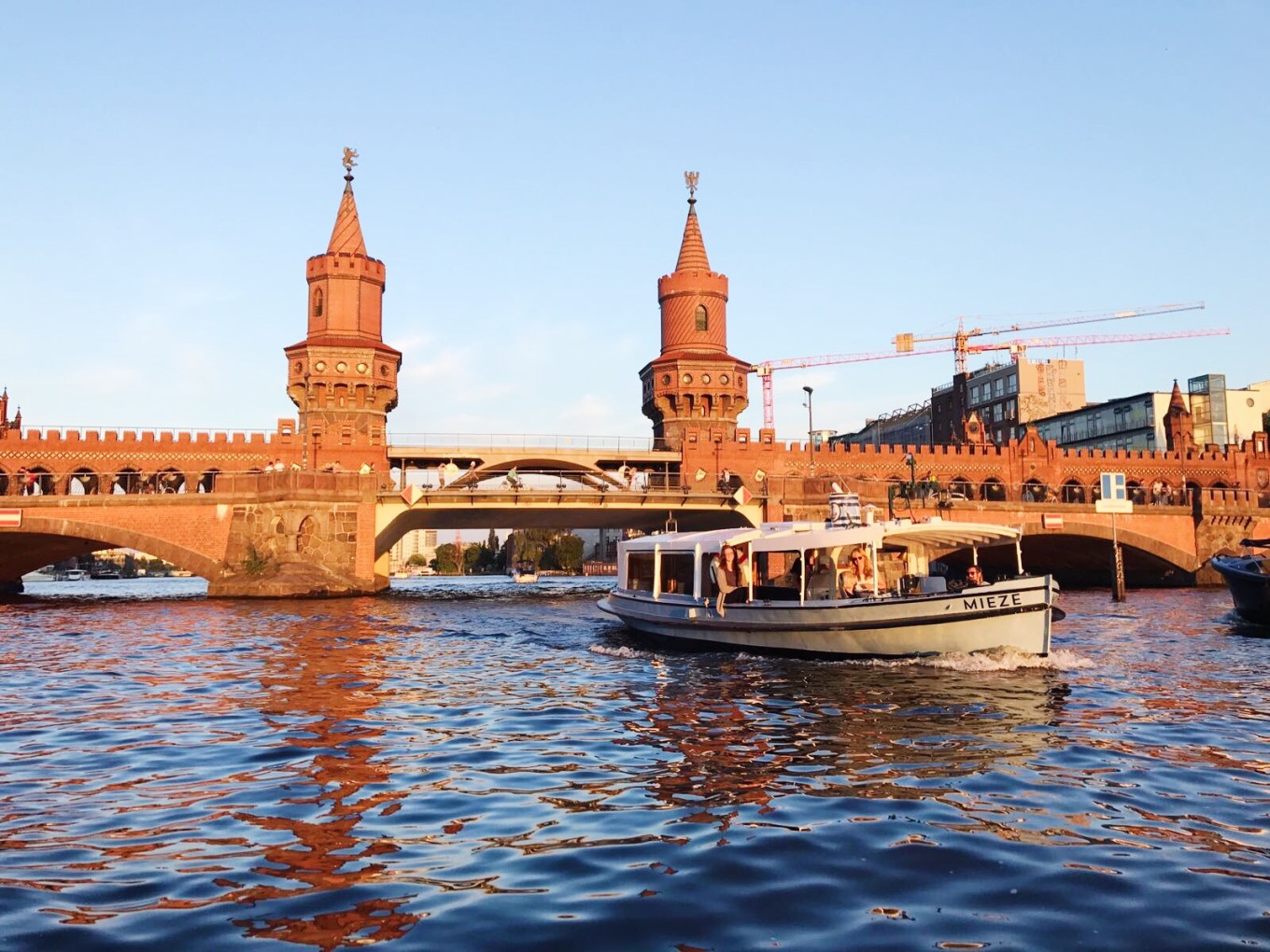
Mercedes-Benz Arena
Next stop, Mercedes-Benz Arena. Situated right behind the Oberbaum Bridge on the starboard side as you're heading up the Spree. The arena is equipped with 17,000 sitting and standing places and is Germany's second biggest multi-functional events venue.
This is home to both Berlin's ice hockey team, Eisbaeren Berlin, and basketball team, Alba Berlin. Besides events of all kinds (for example, MTV European Music Award), you will also find concerts and sports events taking place here.
The arena is a central part of the Media Spree projects and was the reason for many demonstrations in the past years. The large advertising display boards and entrance point meant the removal of parts of the East Side Gallery, which was not a very popular idea amongst many Berliners.
Let's follow the River Spree along the East Side Gallery and we'll come across some of the beach bars on the starboard side (Oststrand, Yaam, and Spindler and Klatt port side). Right after the Schillingbruecke, you'll find the radial system and the location of the previous Bar 25.
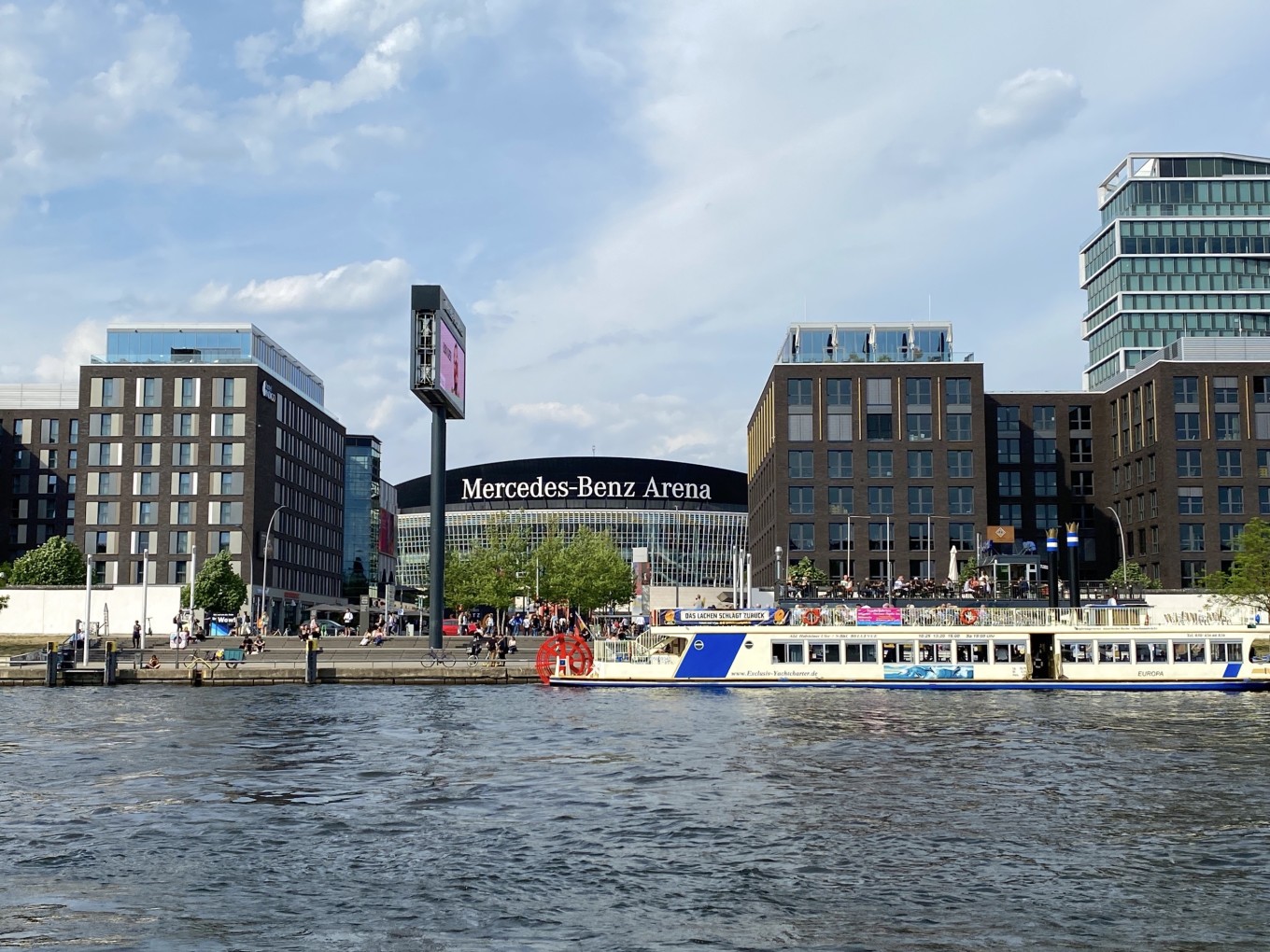
Fischerinsel
Our Berlin boat ride will continue on to the Muehlendammschleuse directly behind the Jannowitzbruecke and left of it, you'll see the Fischerinsel. Fischerinsel (Fisherman Island) is the part of the Spree island which is located south of the Gertrauden-street.
Today you'll find a lot of high riser buildings in this area. This area was not recognised as part of Berlin between 1237 and 1709. From then on, this part of the island became home for fishermen and their families. Between 1967 and 1972, all the buildings (including monuments) were torn down in order to provide space to build DDR standardised housing estates. This housing type WHH GT 18 consists of 296 flats and belongs to the biggest housing builds of the DDR.
The island connects to Berlin's center through the Muehlendammbruecke in the East. Amongst those living in these buildings, were also the famous merchant Hans Kohlhase and Heinrich von Kleist who was once described as "one of the most righteous and yet most terrible men of his time".

Nikolaiviertel
The Nikolaiviertel with the late romantic basilica Nikolaikirche (church) that was built in 1200, is Berlin's oldest living quarters. You'll find it directly behind the Muehlendammschleuse and Muehlendamm Bridge on our boat trip. At that time, the two colonies, Coelln and Berlin, began to develop around the church and remained connected through the Muehlendamm.
Berlin was established in 1237 due to the two colonies growing together from this point on (and in 1307, the double-city unified as Berlin-Coelln). The church was transformed to a gothic hall church in 1264 and further changes followed. In 1870, the old tower of the church (the main feature of the old city center) was reconstructed into neo-Gothic twin towers. While Berlin continued to grow, the Nikolaiviertel more or less remained the home of builders that would carry out their work down those narrow streets. The 2nd World War left this area completely destroyed from the countless number of bombings and leaving it unrecognisable.
Only in 1987 was it decided to restore the old city core, demonstrating its historical significance. The result is considered controversial, as the planning and reconstruction was heavily influenced by a focus for tourism. Existing buildings were restored and new buildings had historical facades added. The reconstructions of the town houses behind the church are regarded as the original. Besides the spire, the church has been restored to its original prior to destruction. The guesthouse 'Zum Nussbaum' which famous artists, such as Heinrich Zille and Claire Waldoff, visited has been replicated at the Nikolaiplatz after being destroyed on the Fischer Insel.
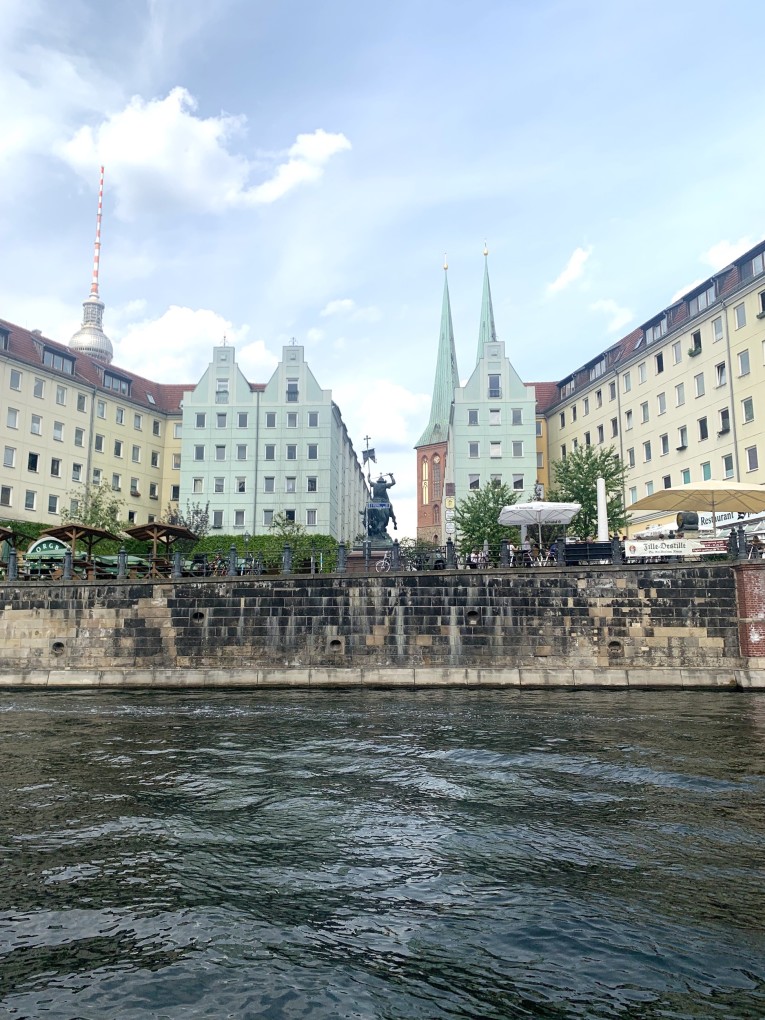
Berliner Dom
The Berlin Cathedral (Berliner Dom) belongs to belongs to Germany's most important protestant church buildings. The church sits right beside the River Spree.
It was built from 1894 to 1905 following the planning designs of Julius Raschdorff on the Spree Island, which is known today as Mitte (modeled after High Renaissance and Baroque).
The church is a listed building and consists of sermon, christening and wedding chapel. Between 1536 and 1916 members of the former Prussian royal family (Hohenzollern) were buried in the crypt of the church.
Today, the Dom holds church services and important political events. The main entrance is to directly on Berlin's Lustgarten. Our boat tour on Berlin's Spree continues past Museum Island where you'll see all its other numerous attractions.
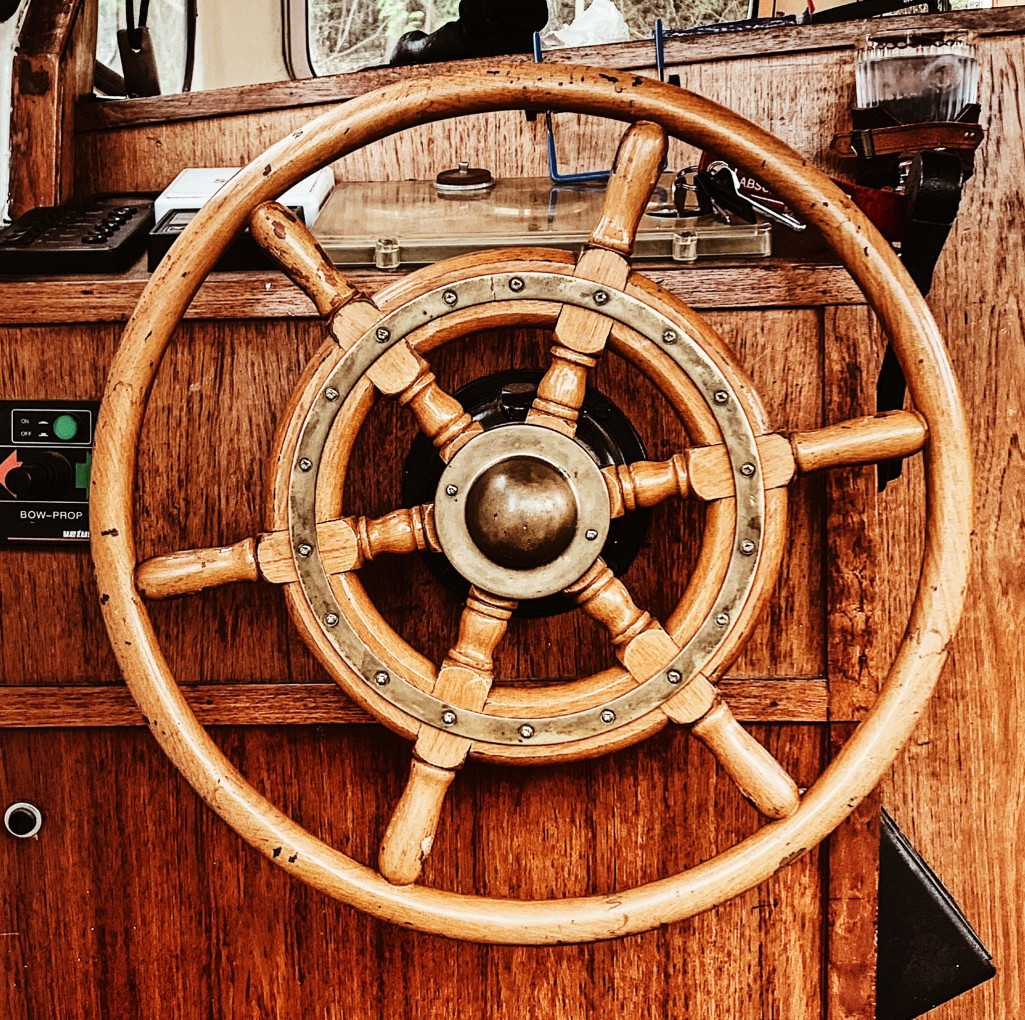
Museumsinsel
Museum island lies at the northern end of the Spree island. UNESCO awarded Museumsinsel with the title of World Heritage Site in 1999 because of its unique cultural and architectural qualities. It is the center of Berlin's museum and cultural landscape and one of the world's most important museum complexes.
In 1810, Friedrich Wilhelm II decided to create "a public, well-selected collection of art". 12 years later, Karl Friedrich Schinkel submitted plans for a restructuring of the Spree Island. These included not only museums, but also several bridges and the straightening of the Kupfergraben. The former was led by a commission headed by Wilhelm von Humboldt.
In 1830, the Alte Museum (old museum) was built, followed by the Royal Prussian Museum in 1859, the National Gallery (Alte Nationalgalerie) in 1876, the Kaiser Friedrich Museum (Bode Museum) in 1904, and the Pergamon Museum in 1930. The Pergamon houses the German Museum, a collection of antiques including the Pergamon altar, the Middle East Museum and the Museum of Islamic Art.
Most of the museums were destroyed during the 2nd World War. The repairing process only started in 1999 after reunification. The River Spree cruise will now take us to Friedrichstrasse (Weidendamm Bridge).
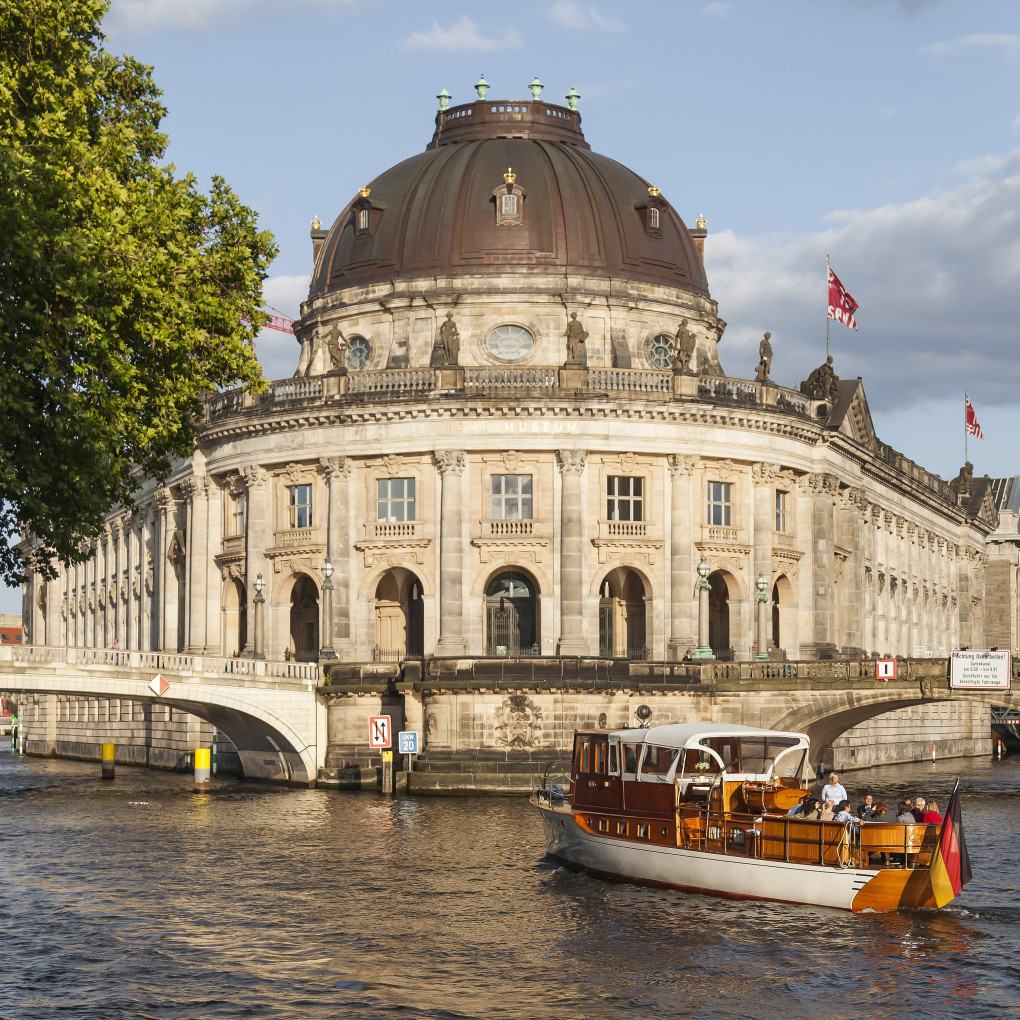
Friedrichstraße
Friedrichstrasse is probably one of the most famous streets of reunited Berlin. It was named after the Elector Friedrich III of Brandenburg, who opposed the original name 'crossroads'.
He claimed, "What do you mean cross roads? A decent name it must be - that of mine".
The most prominent buildings and structures on this street include the Friedrichstadt Palace, Admiral Palace, Tear Palace, the Frank Meisler Monument for children's transport at the station, the International Trading Center, Gallery Lafayette, Checkpoint Charlie, Mauermuseum, and the Landesarbeitsamt (National Labour Office). This was built in 1940 and is the perfect example of the Nazi monumental architecture.
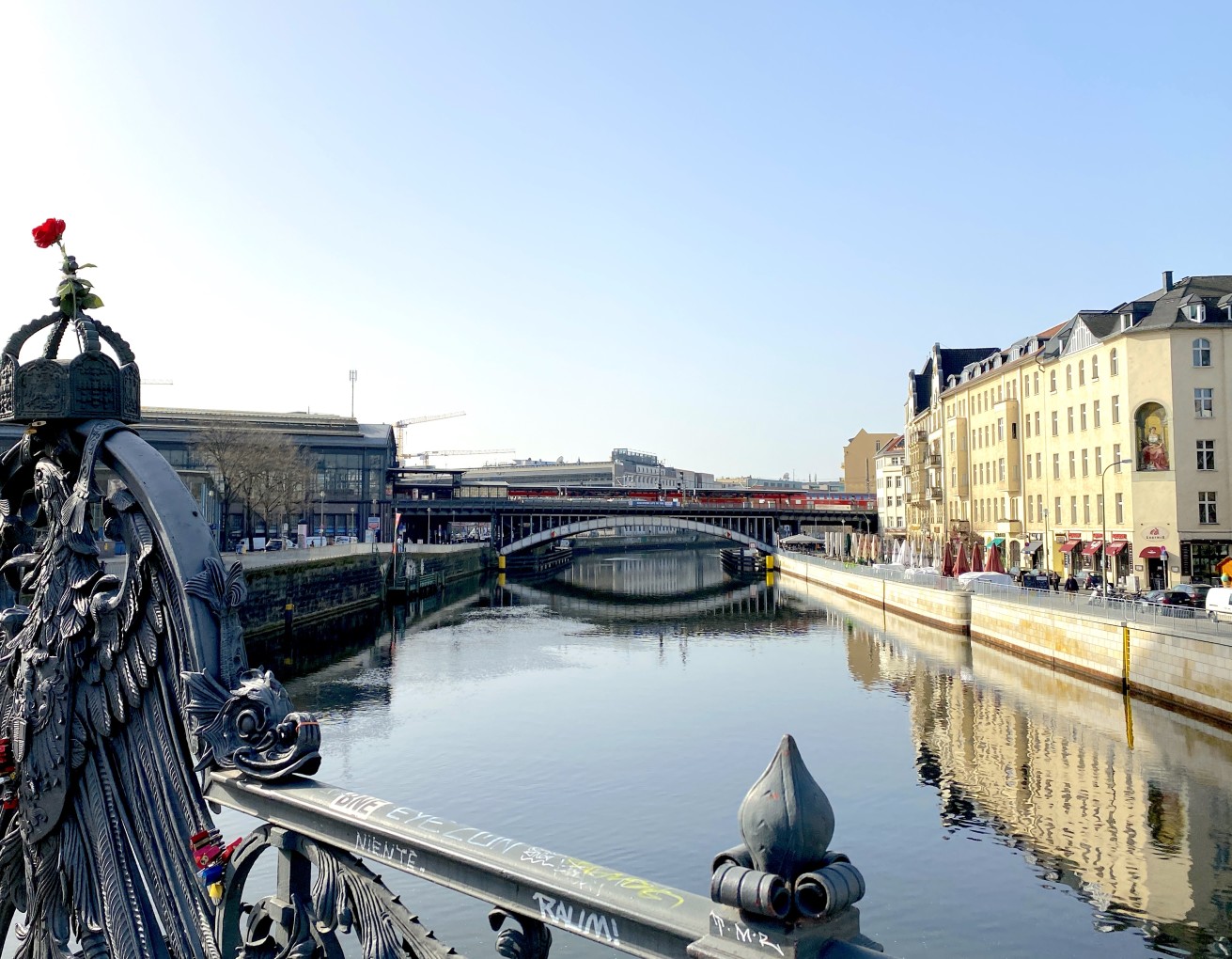
Schiffbauerdamm
A Spree River Cruise will take you past the Schiffbauerdamm, which is located in the district of Berlin Mitte. This sight is still part of Berlin's long standing tradition, as numerous shipbuilders were located here.
Of the many buildings that used to stand here, unfortunately only three can still be seen today. In 1998 the Federal Republic took ownership and these buildings are now listed.
These structures are witnesses of the extraordinary history of the federal capital and their traditions. The Kurfuersten (electors) realised their plans for shipbuilding in this place and later built countless warships at the Schiffbauerdamm.
Later magnificent buildings were built around this area, including architectural features that are particularly worth seeing. Today people rent these buildings. The administration building is used by the German Bundestag, the boiler house and engine house were leased to the news agency Reuters, and the television stations RTL and N-TV are also at home in these historic buildings. The boat ride continues towards the Reichstag.
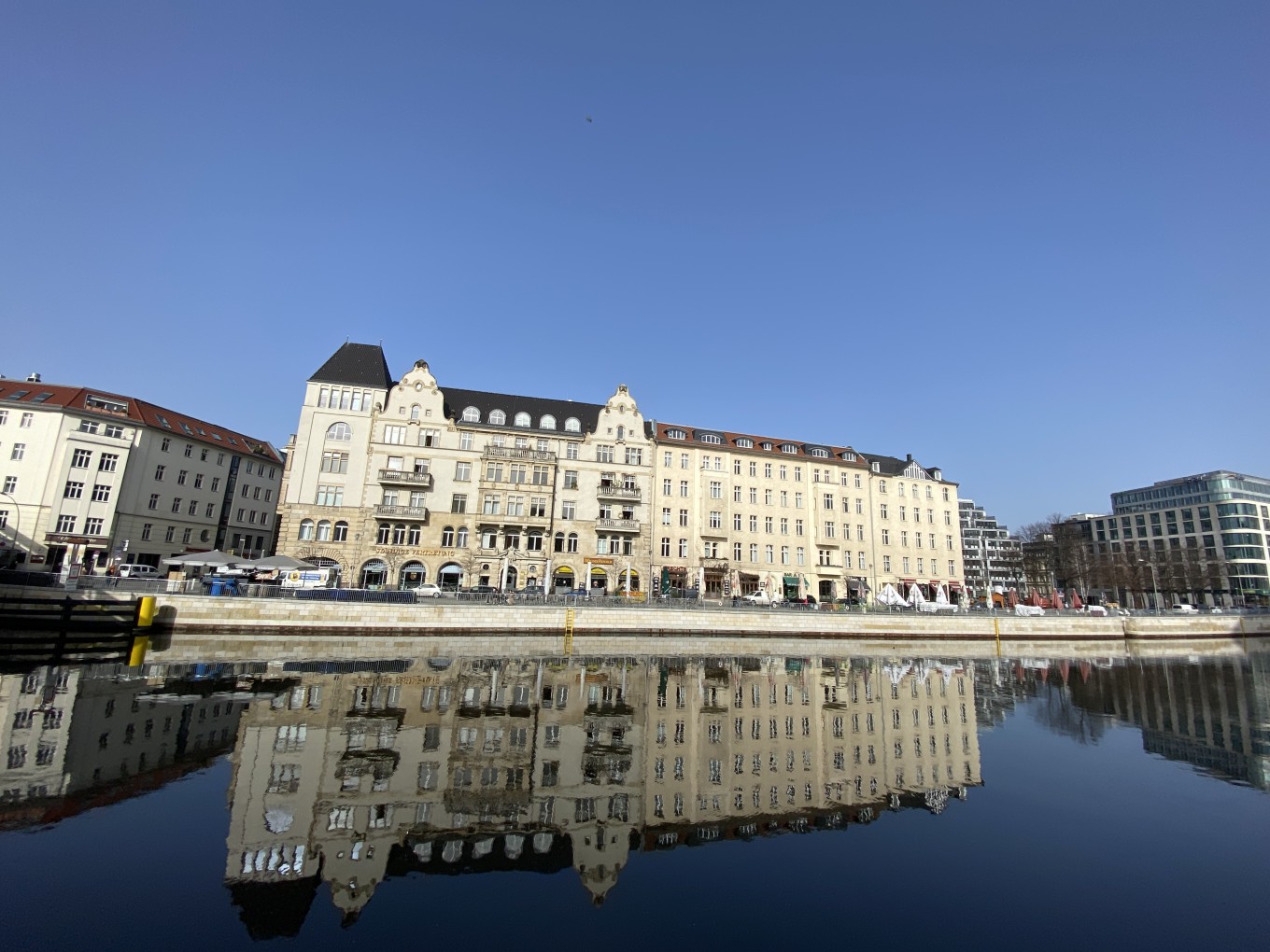
Reichstag
There is hardly another building in Germany that has such a history. The Reichstag is also the building where the future of the country is determined. The building is located in the Tiergarten district and was built by architect Paul Wallot (1884-1894).
The neo-Renaissance style stands out today amongst all the other buildings. Until 1918, the Reichstag was the seat of the Empire, and later housed the parliament of the Weimarer Republic. In 1933, before the 2nd World War, the building was damaged by arson. It was restored in the 1960s and again rebuilt in the 1990s.
Even today, the fate of the country is determined from this very place. A special feature are the artistic activities that take place in the Reichstag. Not only the famous wrapping of the Reichstag by the artist Christo is a cultural and artistic peculiarity of the building. There have also been exhibitions showing different sculptures, paintings and collages all around the building. In addition, the Reichstag is a popular tourist attraction and brings thousands of visitors each year. The River Spree Cruise continues towards the Government district.
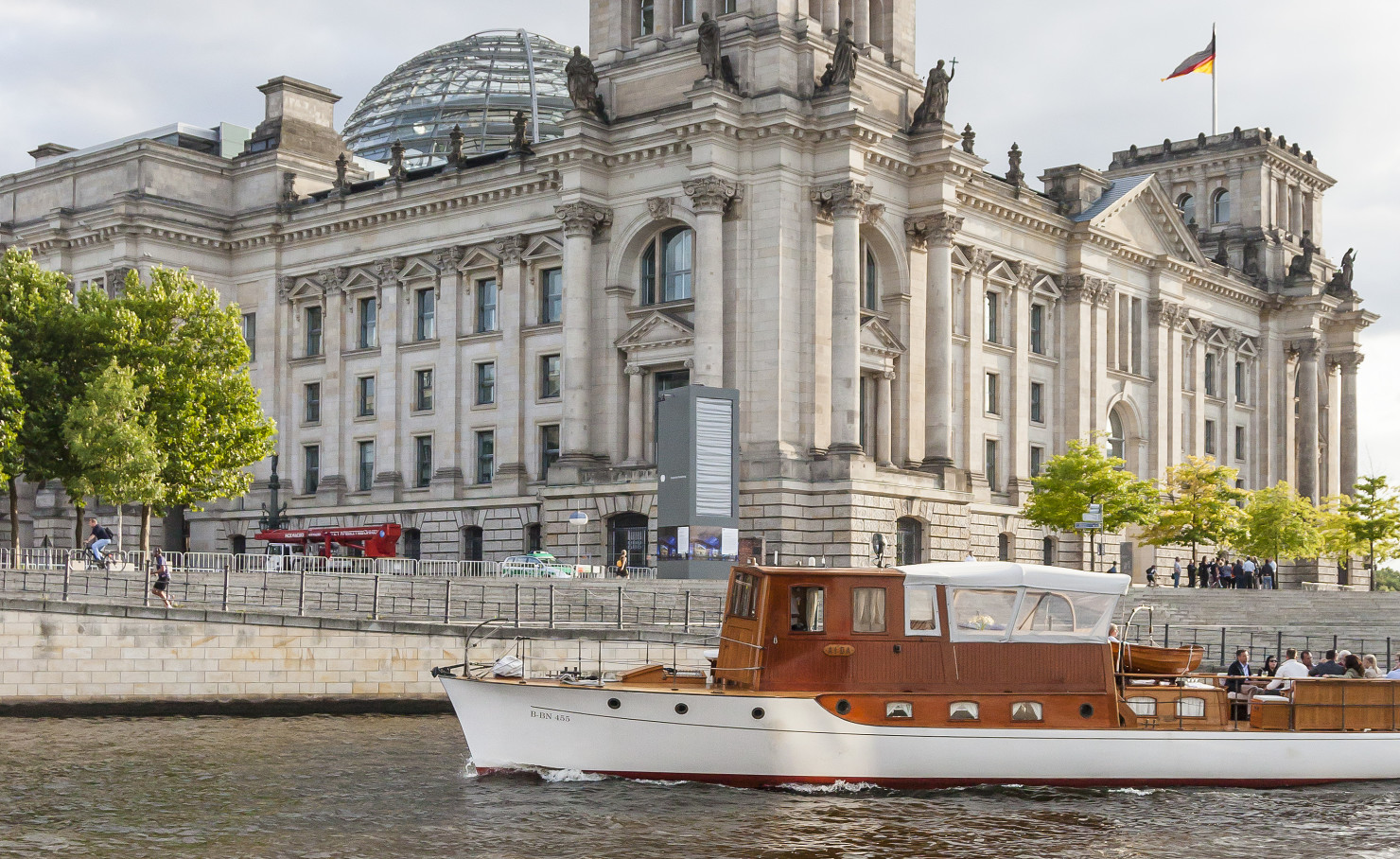
Regierungsviertel
The Regierungsviertel (Government district) in Berlin-Tiergarten and Berlin-Mitte is a special attraction. The central point is the Reichstag building, which is home to the plenary hall of the German Bundestag. You will also find the chancellor's office, the offices of German members of parliament and various meeting rooms. Federal ministries and the Federal Council are also at home in this place, which was already serving special significance for the country in imperial times.
Originally used only for the Reichstag, the reunification in 1990 brought a completely new purpose to the building which it still serves today. It was due to lack of money that no new buildings were being built, so the city invested what it had into the old historical buildings. Still standing today, these restored original buildings help paint a picture of Berlin's history. Therefore the Regierungsviertel ties in directly to the historical circumstances and serves as a reminder of the partition of Germany and the Third Reich. Our boat tour continues towards the Hauptbahnhof (Central station).
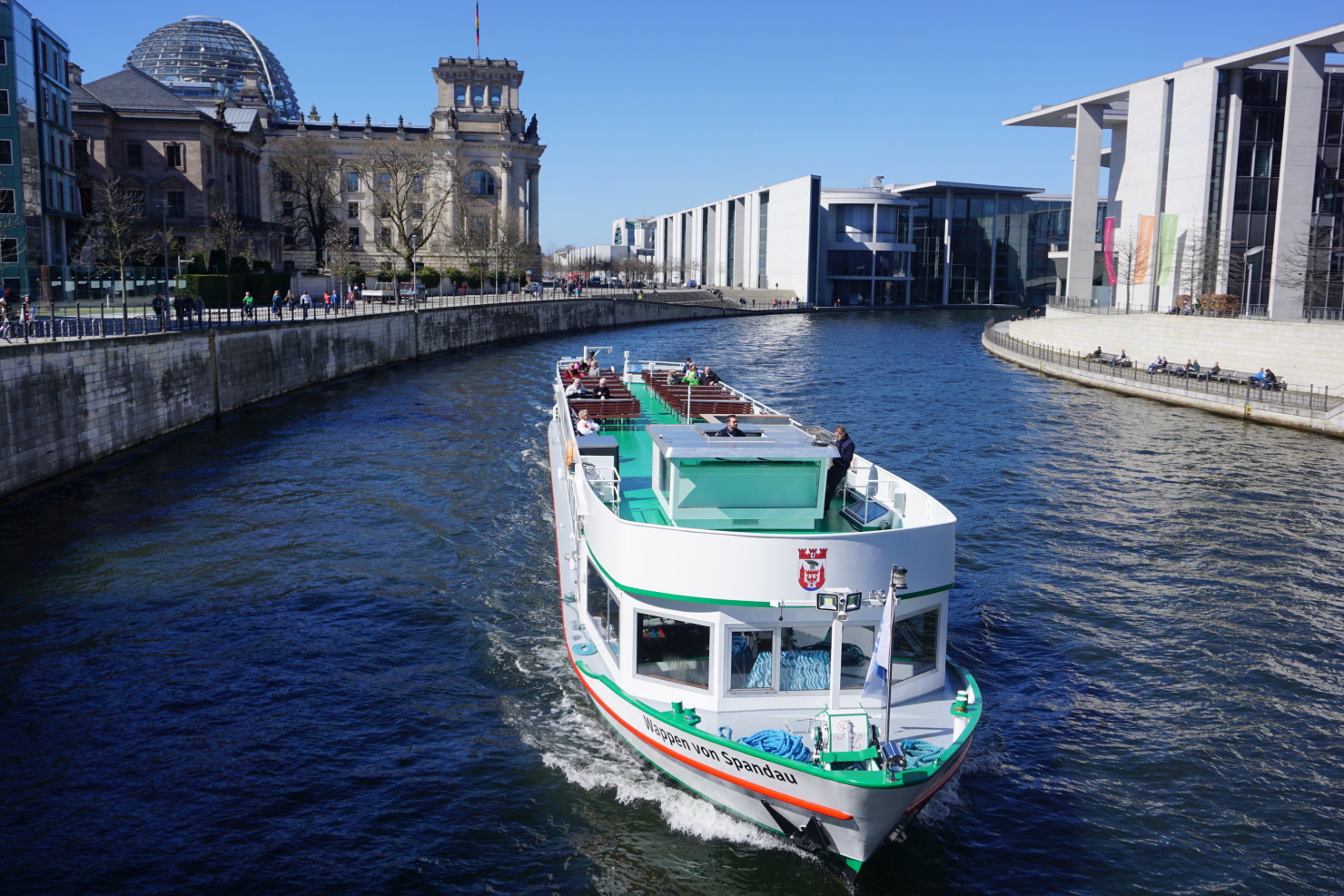
Hauptbahnhof
A special attraction is the Berlin Central Station. It is the largest tower station in Europe. 300.000 people pass through this station on a daily basis, hopping on and off the trains, making it the fourth largest passenger station in Germany.
Due to its unique design, the station was awarded as 'station of the year' by the Pro-Rail Alliance in 2007. Around 70.000 square meters are available. The train station, however, is not only an interest for rail travelers. It is a great place to pass some time with its three floors of 15.000 square feet retail space. You'll find more than 80 shops, including clothing shops, wellness and healthcare companies. In addition, there are a variety of cafes which are very inviting for people to linger. Not only do the shops and retail options make this station interesting. Its architecture is a special feature made of steel and glass. A flowing design that also covers the train crossings. The design of the station was also honored with an award in 2008. Overall, the train station is a real experience and a great start for sightseeing. Our boat tour continues towards Schloss Bellevue.
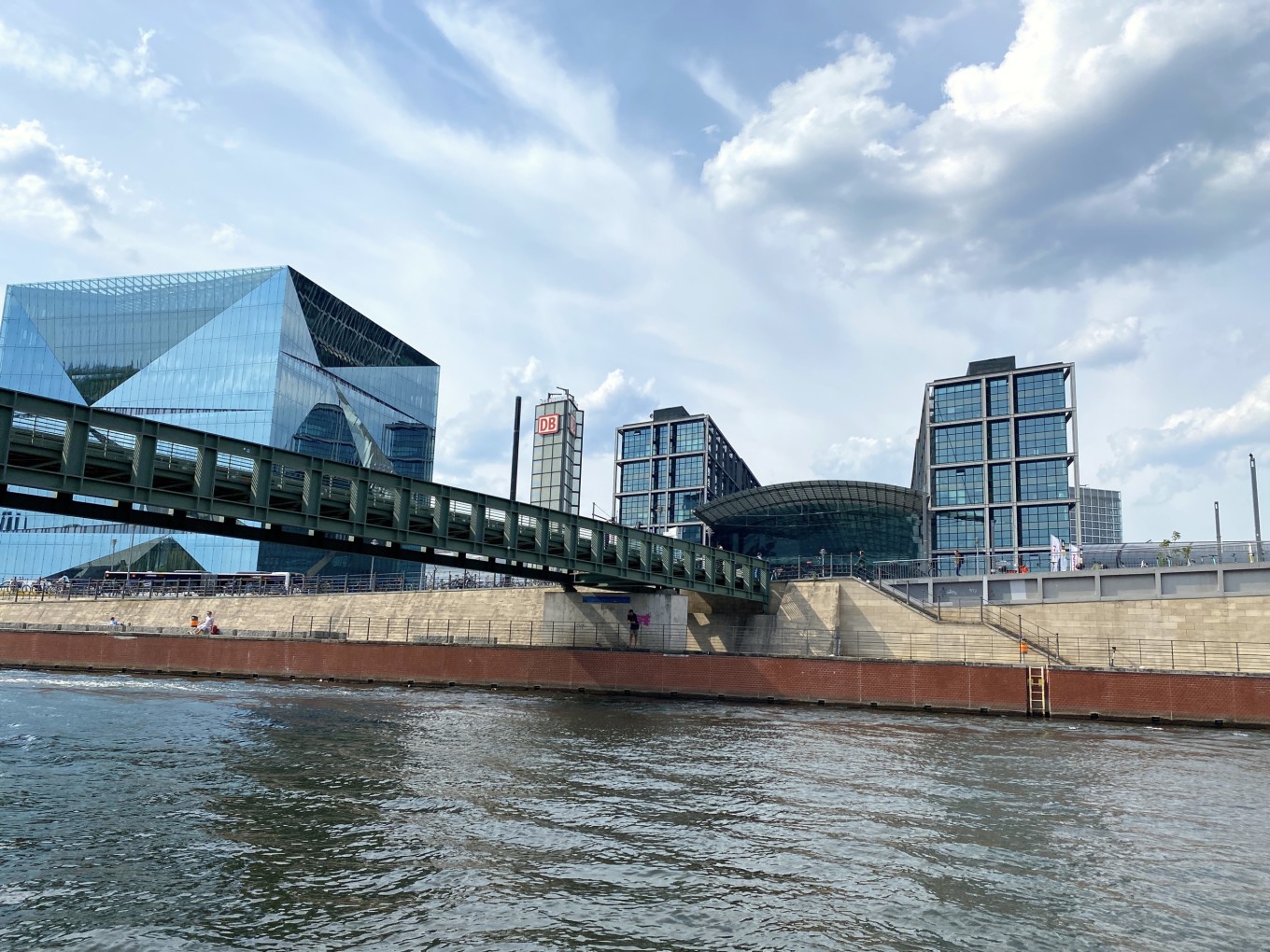
Schloss Bellevue
The Bellevue Palace (Schloss Bellevue) is certainly one of the most famous places in Germany. The magnificent building now serves as the seat of the Federal President, who takes over his official duties from here. It's situated on the northern edge of the district Tiergarten and is located in the immediate vicinity of the Reichstag, the Siegessaeule (Victory Column), and the Brandenburg Gate.
Built in 1786, it was the first seat of Ferdinand of Prussia. At that time, it was a summer residence and is still witness to the splendor that prevailed at that time. This early classical style building is a rarity these days and can only be found in a few buildings today. The castle was also used as a pleasure palace in the 19th century. Today, it's not only its functional use that impresses, it's also the architectural style and the large park-like garden that are remarkable features of the castle. Our boat trip goes on to the Siegessaeule (Victory Column).
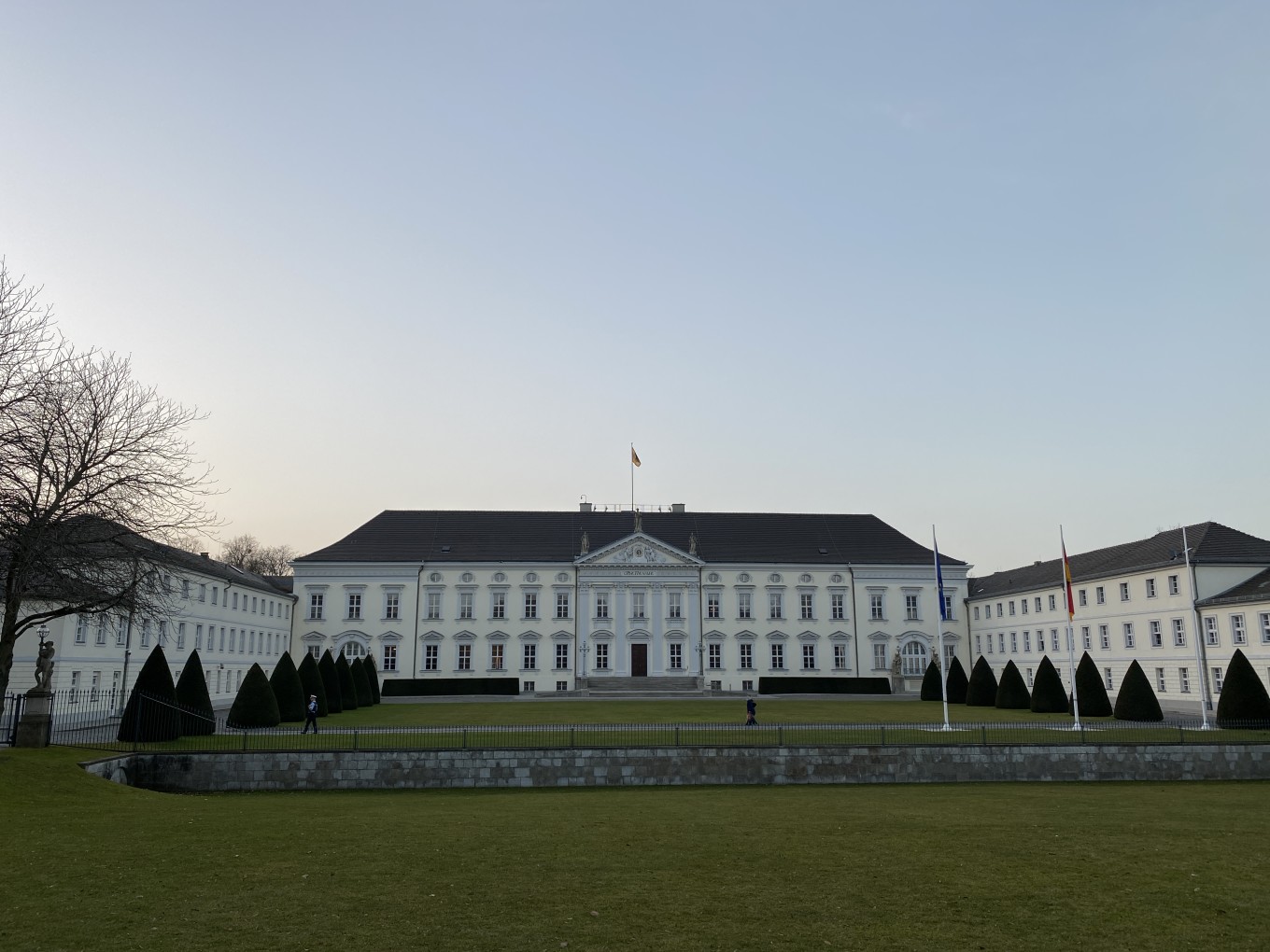
Siegessäule
The Siegessaeule is a world famous monument that adorns the Tiergarten park in the middle of Berlin. Originally built as a national monument of the Unification War in the 19th century, the column still plays a major role today. Presidents, such as Barrack Obama, have held speeches in front of the column that have crossed far beyond the borders of Germany. The Siegessaeule was also the site of the Love Parade and many other great events.
Around the base of the monument, you'll find a relief that depicts the reason for this building. Pictured are historical people, including the architect of the building (Heinrich Strack), who conceived the Siegessaeule after the victory of Prussia over the German-Danish army in 1871. The war actually consisted of three wars. For every victory, a separate segment was built so that the original Siegessaeule consists of three segments. The Victoria (the figure at the top), is the crowning glory. Due to its importance, the column is part of the "Strasse der Monumente" (street of monuments) that connects different places and sights in Berlin. Our boat ride continues further in the direction of the Hansa Quarter.
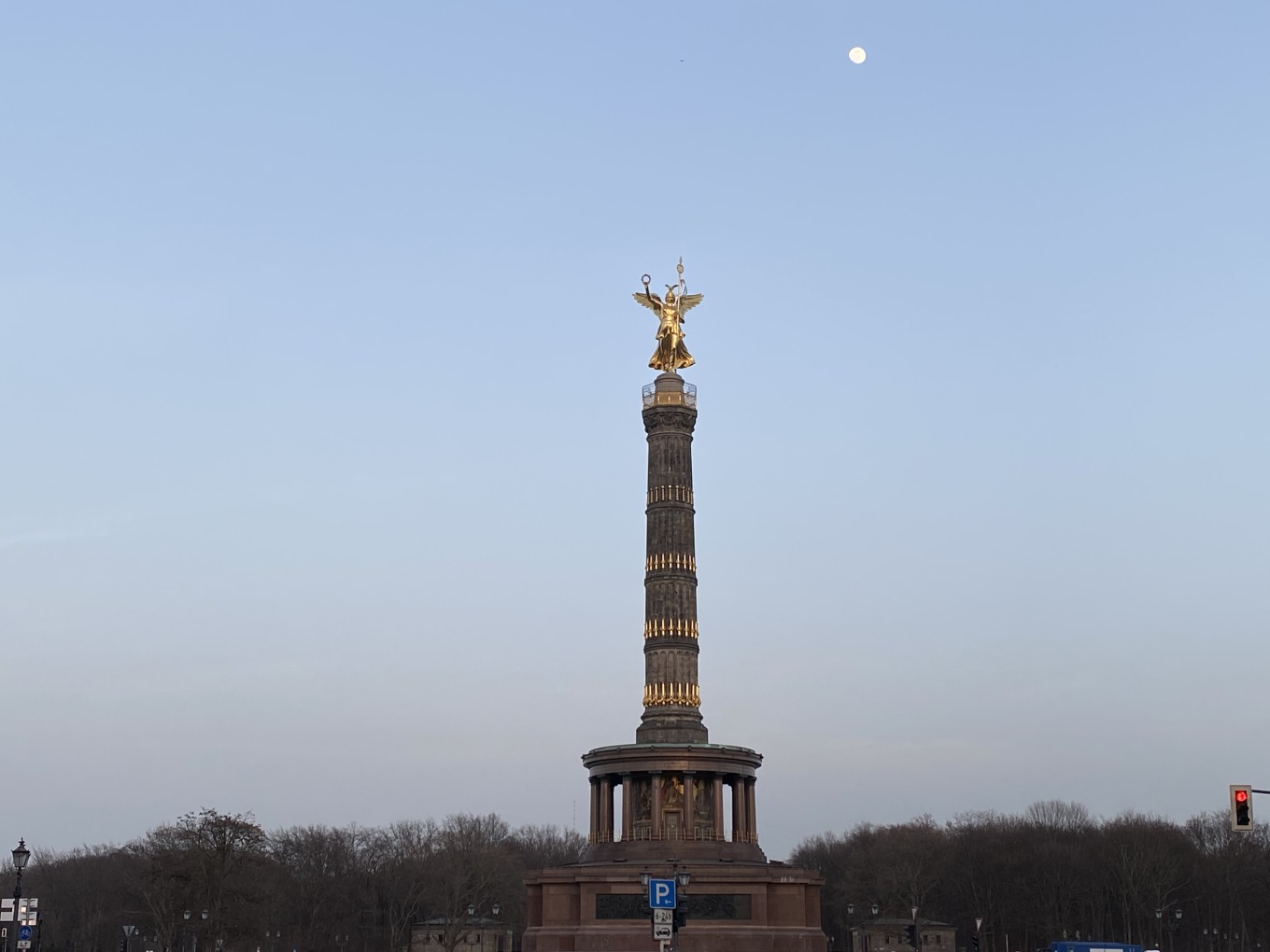
Hansaviertel
The Hansa Quarter is part of the Mitte district. Although it already existed in the 19th century, modern buildings now dominate most of the neighborhood. The Hansa Quarter is split by the public rail service into two distinct parts of approximately the same size. One half is heavily covered in residential development with very little commercialism. And yet, it is still an attraction for tourists. You'll find the Academy of Arts, which hosts numerous events. In addition, the Grips Theater is also a highlight. The theater first began performing pieces exclusively for children and young people. Only in 1980 did they start putting on pieces for adults.
This part of the city, however, is not only popular because of its obvious attractions. Albert Einstein visited the district's synagogue and other well-known figures, such as Rosa Luxembourg and Kurt Tucholsky found homes in the Hansa Quarter for a time being. The area is often suggested for tourists to visit for these reasons. This is where our main route along the Spree ends.

Boat trips in Berlin
The first two routes are especially frequented by passenger ships and are very popular with tourists. But it is also hard to imagine the Spree without party boats. Many smaller boat companies also offer the possibility of a private tour with music and a barbecue. On the Spree River you will also pass a number of party locations and beach bars.

